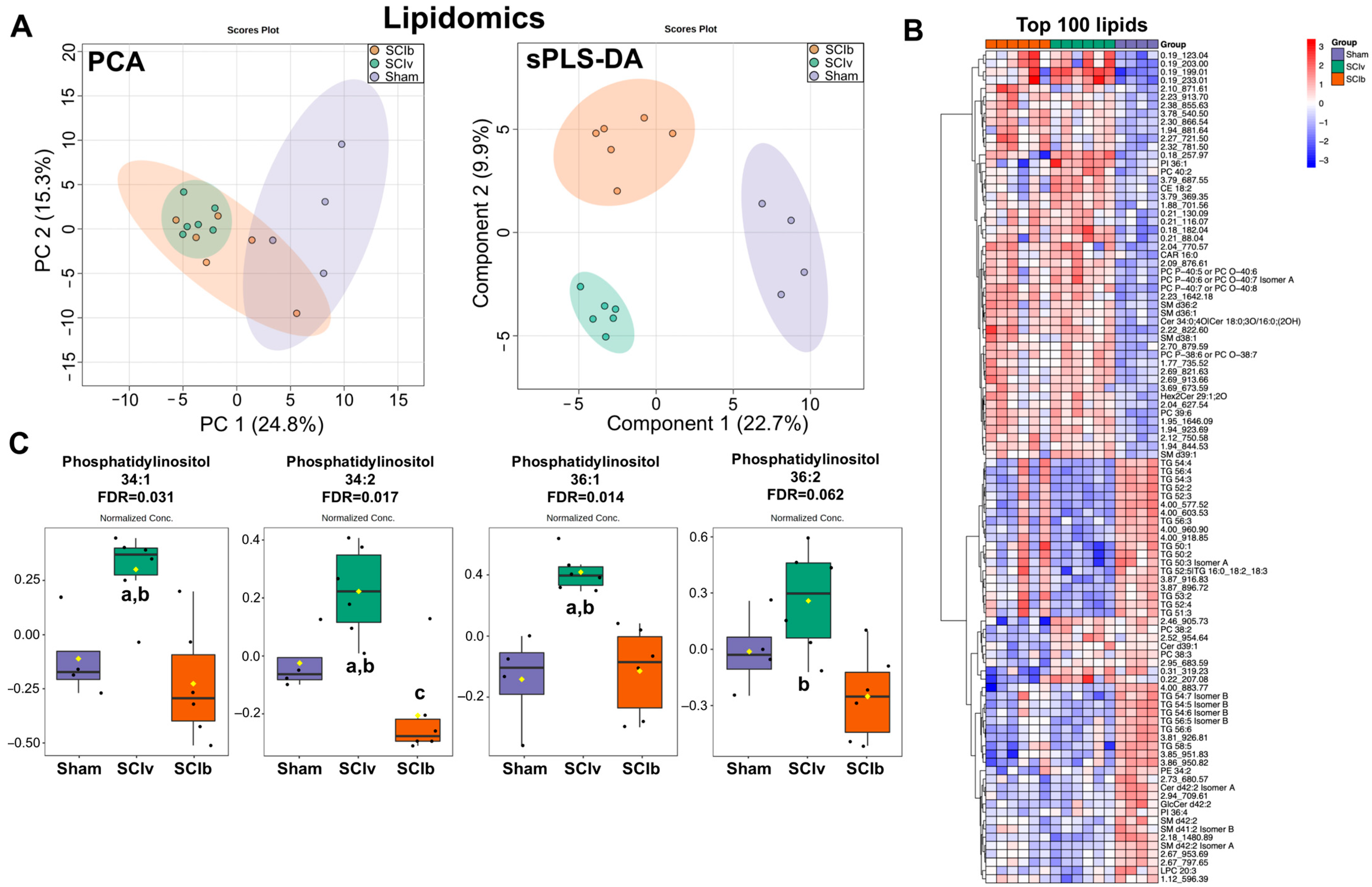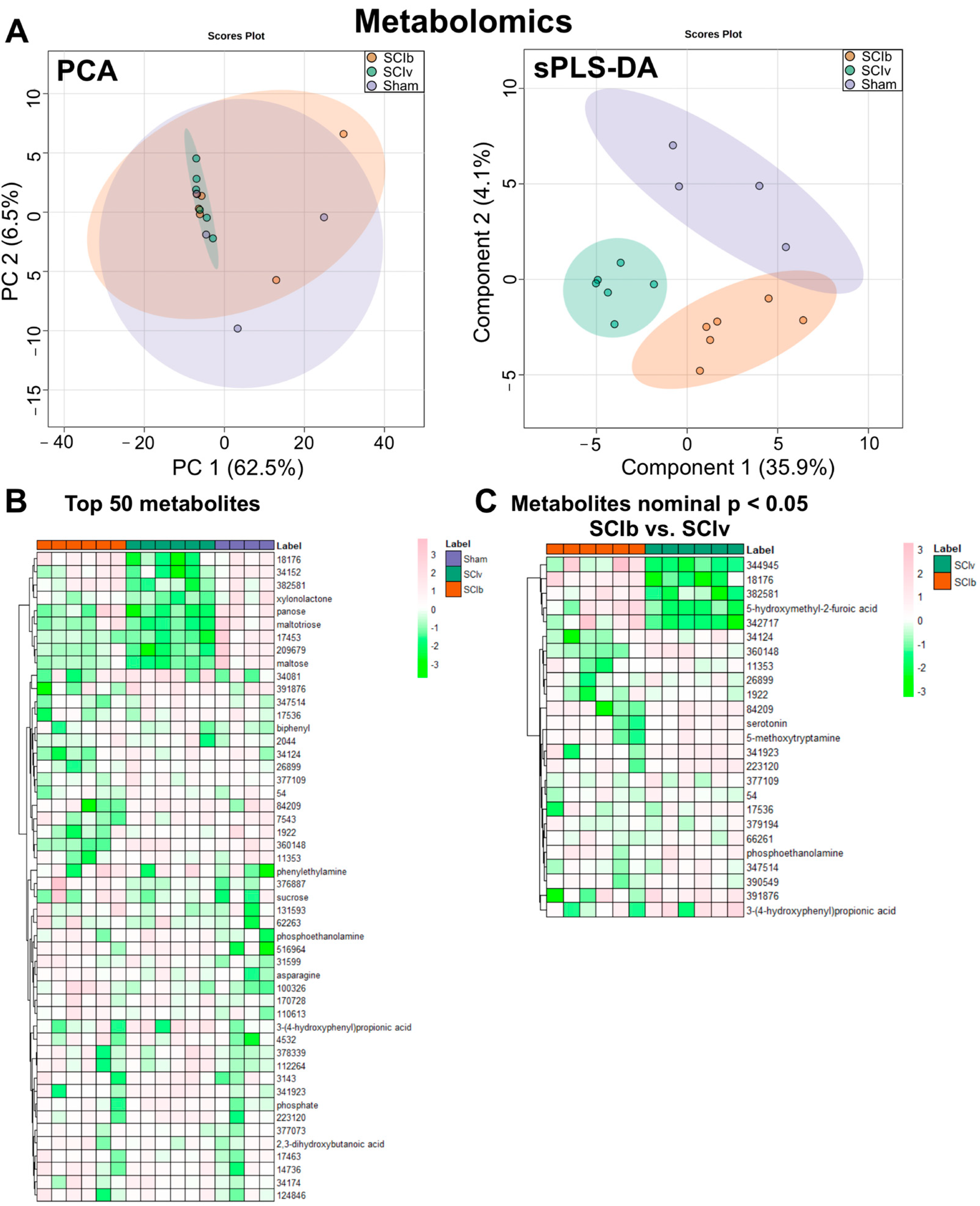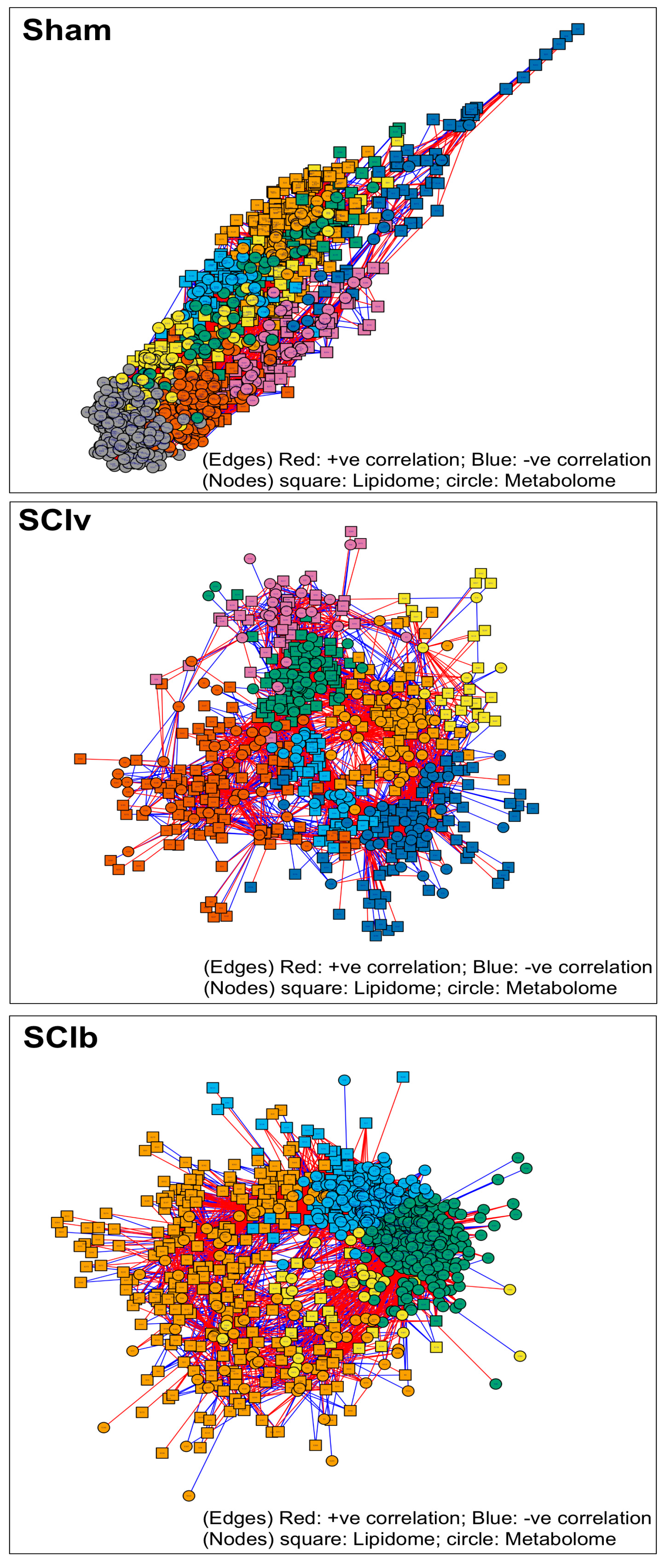Boldine Alters Serum Lipidomic Signatures after Acute Spinal Cord Transection in Male Mice
Abstract
:1. Introduction
2. Methods
2.1. Animals
2.2. Laminectomy and Spinal Cord Transection
2.3. Post-Operative Care and Boldine Administration
2.4. Metabolomics and Lipidomic Sample Processing and Data Analysis
2.5. xMWAS
3. Results
3.1. Lipidomics
3.2. Metabolomics
3.3. xMWAS
4. Discussion
Supplementary Materials
Author Contributions
Funding
Institutional Review Board Statement
Informed Consent Statement
Data Availability Statement
Conflicts of Interest
References
- Bauman, W.; Korsten, M.; Radulovic, M.; Schilero, G.; Wech, J.; Spungen, A. 31st G. Heiner Sell Lectureship: Secondary Medical Consequences of Spinal Cord Injury. Top. Spinal Cord Inj. Rehabil. 2012, 18, 354–378. [Google Scholar] [CrossRef] [PubMed]
- Kobayakawa, K.; Kumamaru, H.; Saiwai, H.; Kubota, K.; Ohkawa, Y.; Kishimoto, J.; Yokota, K.; Ideta, R.; Shiba, K.; Tozaki-Saitoh, H.; et al. Acute hyperglycemia impairs functional improvement after spinal cord injury in mice and humans. Sci. Transl. Med. 2014, 6, 256ra137. [Google Scholar] [CrossRef] [PubMed]
- Thibault-Halman, G.; Casha, S.; Singer, S.; Christie, S.; Gaudet, A.D.; Fonken, L.K.; Ayala, M.T.; Dangelo, H.M.; Smith, E.J.; Bateman, E.M.; et al. Acute Management of Nutritional Demands after Spinal Cord Injury. J. Neurotrauma 2011, 28, 1497–1507. [Google Scholar] [CrossRef] [PubMed]
- Graham, Z.A.; Siedlik, J.A.; Harlow, L.; Sahbani, K.; Bauman, W.A.; Tawfeek, H.A.; Cardozo, C.P. Key Glycolytic Metabolites in Paralyzed Skeletal Muscle Are Altered Seven Days after Spinal Cord Injury in Mice. J. Neurotrauma 2019, 36, 2722–2731. [Google Scholar] [CrossRef]
- Potter, L.A.; Toro, C.A.; Harlow, L.; Lavin, K.M.; Cardozo, C.P.; Wende, A.R.; Graham, Z.A. Assessing the impact of boldine on the gastrocnemius using multiomics profiling at 7 and 28 days post-complete spinal cord injury in young male mice. Physiol. Genom. 2023, 55, 297–313. [Google Scholar] [CrossRef]
- Li, V.L.; He, Y.; Contrepois, K.; Liu, H.; Kim, J.T.; Wiggenhorn, A.L.; Tanzo, J.T.; Tung, A.S.-H.; Lyu, X.; Zushin, P.-J.H.; et al. An exercise-inducible metabolite that suppresses feeding and obesity. Nature 2022, 606, 785–790. [Google Scholar] [CrossRef]
- Stanford, K.I.; Lynes, M.D.; Takahashi, H.; Baer, L.A.; Arts, P.J.; May, F.J.; Lehnig, A.C.; Middelbeek, R.J.W.; Richard, J.J.; So, K.; et al. 12,13-diHOME: An Exercise-Induced Lipokine that Increases Skeletal Muscle Fatty Acid Uptake. Cell Metab. 2018, 27, 1111–1120.e3. [Google Scholar] [CrossRef]
- Peng, J.; Zeng, J.; Cai, B.; Yang, H.; Cohen, M.J.; Chen, W.; Sun, M.-W.; Lu, C.D.; Jiang, H. Establishment of Quantitative Severity Evaluation Model for Spinal Cord Injury by Metabolomic Fingerprinting. PLoS ONE 2014, 9, e93736. [Google Scholar] [CrossRef]
- Wu, Y.; Streijger, F.; Wang, Y.; Lin, G.; Christie, S.; Mac-Thiong, J.-M.; Parent, S.; Bailey, C.S.; Paquette, S.; Boyd, M.C.; et al. Parallel Metabolomic Profiling of Cerebrospinal Fluid and Serum for Identifying Biomarkers of Injury Severity after Acute Human Spinal Cord Injury. Sci. Rep. 2016, 6, 38718. [Google Scholar] [CrossRef]
- Toro, C.A.; Johnson, K.; Hansen, J.; Siddiq, M.M.; Vásquez, W.; Zhao, W.; Graham, Z.A.; Sáez, J.C.; Iyengar, R.; Cardozo, C.P. Boldine modulates glial transcription and functional recovery in a murine model of contusion spinal cord injury. Front Cell Neurosci. 2023, 17, 1163436. [Google Scholar] [CrossRef]
- Yi, C.; Ezan, P.; Fernández, P.; Schmitt, J.; Sáez, J.C.; Giaume, C.; Koulakoff, A. Inhibition of glial hemichannels by boldine treatment reduces neuronal suffering in a murine model of Alzheimer’s disease. Glia 2017, 65, 1607–1625. [Google Scholar] [CrossRef] [PubMed]
- Hernández-Salinas, R.; Vielma, A.Z.; Arismendi, M.N.; Boric, M.P.; Sáez, J.C.; Velarde, V. Boldine Prevents Renal Alterations in Diabetic Rats. J. Diabetes Res. 2013, 2013, 593672. [Google Scholar] [CrossRef]
- Cea, L.A.; Cisterna, B.A.; Puebla, C.; Frank, M.; Figueroa, X.F.; Cardozo, C.; Willecke, K.; Latorre, R.; Sáez, J.C. De novo expression of connexin hemichannels in denervated fast skeletal muscles leads to atrophy. Proc. Natl. Acad. Sci. USA 2013, 110, 16229–16234. [Google Scholar] [CrossRef]
- Cea, L.A.; Balboa, E.; Puebla, C.; Vargas, A.A.; Cisterna, B.A.; Escamilla, R.; Regueira, T.; Sáez, J.C. Dexamethasone-induced muscular atrophy is mediated by functional expression of connexin-based hemichannels. Biochim. Biophys. Acta (BBA)—Mol. Basis Dis. 2016, 1862, 1891–1899. [Google Scholar] [CrossRef] [PubMed]
- Cea, L.A.; Balboa, E.; Vargas, A.A.; Puebla, C.; Brañes, M.C.; Escamilla, R.; Regueira, T.; Sáez, J.C. De novo expression of functional connexins 43 and 45 hemichannels increases sarcolemmal permeability of skeletal myofibers during endotoxemia. Biochim. Biophys. Acta (BBA)—Mol. Basis Dis. 2019, 1865, 2765–2773. [Google Scholar] [CrossRef] [PubMed]
- Cisterna, B.A.; Vargas, A.A.; Puebla, C.; Fernández, P.; Escamilla, R.; Lagos, C.F.; Matus, M.F.; Vilos, C.; Cea, L.A.; Barnafi, E.; et al. Active acetylcholine receptors prevent the atrophy of skeletal muscles and favor reinnervation. Nat. Commun. 2020, 11, 1073. [Google Scholar] [CrossRef]
- Cea, L.A.; Vásquez, W.; Hernández-Salinas, R.; Vielma, A.Z.; Castillo-Ruiz, M.; Velarde, V.; Salgado, M.; Sáez, J.C. Skeletal Muscle Atrophy Induced by Diabetes Is Mediated by Non-Selective Channels and Prevented by Boldine. Biomolecules 2023, 13, 708. [Google Scholar] [CrossRef]
- National Spinal Cord Injury Statistical Center. Facts and Figures at a Glance; University of Alabama at Birmingham: Birmingham, AL, USA, 2021; Available online: https://www.nscisc.uab.edu/Public/Facts%20and%20Figures%20-%202021.pdf (accessed on 3 April 2023).
- Curtin, C.M.; Suarez, P.A.; Di Ponio, L.A.; Frayne, S.M. Who are the women and men in Veterans Health Administration’s current spinal cord injury population? J. Rehabil. Res. Dev. 2012, 49, 351–360. [Google Scholar] [CrossRef]
- Graham, Z.A.; Collier, L.; Peng, Y.; Saéz, J.C.; Bauman, W.A.; Qin, W.; Cardozo, C.P. A Soluble Activin Receptor IIB Fails to Prevent Muscle Atrophy in a Mouse Model of Spinal Cord Injury. J. Neurotrauma 2015, 33, 1128–1135. [Google Scholar] [CrossRef]
- Fiehn, O.; Garvey, W.T.; Newman, J.W.; Lok, K.H.; Hoppel, C.L.; Adams, S.H. Plasma Metabolomic Profiles Reflective of Glucose Homeostasis in Non-Diabetic and Type 2 Diabetic Obese African-American Women. PLoS ONE 2010, 5, e15234. [Google Scholar] [CrossRef]
- Pang, Z.; Chong, J.; Zhou, G.; de Lima Morais, D.A.; Chang, L.; Barrette, M.; Gauthier, C.; Jacques, P.-É.; Li, S.; Xia, J. MetaboAnalyst 5.0: Narrowing the gap between raw spectra and functional insights. Nucleic Acids Res. 2021, 49, W388–W396. [Google Scholar] [CrossRef] [PubMed]
- Graham, Z.A.; DeBerry, J.J.; Cardozo, C.P.; Bamman, M.M. SS-31 does not prevent or reduce muscle atrophy 7 days after a 65 kdyne contusion spinal cord injury in young male mice. Physiol. Rep. 2022, 10, e15266. [Google Scholar] [CrossRef] [PubMed]
- Skogerson, K.; Wohlgemuth, G.; Barupal, D.K.; Fiehn, O. The volatile compound BinBase mass spectral database. BMC Bioinform. 2011, 12, 321. [Google Scholar] [CrossRef] [PubMed]
- Uppal, K.; Ma, C.; Go, Y.-M.; Jones, D.P. xMWAS: A data-driven integration and differential network analysis tool. Bioinformatics 2018, 34, 701–702. [Google Scholar] [CrossRef]
- Rohart, F.; Gautier, B.; Singh, A.; Lê Cao, K.-A. mixOmics: An R package for ‘omics feature selection and multiple data integration. PLoS Comput. Biol. 2017, 13, e1005752. [Google Scholar] [CrossRef]
- Blondel, V.D.; Guillaume, J.-L.; Lambiotte, R.; Lefebvre, E. Fast unfolding of communities in large networks. J. Stat. Mech. Theory Exp. 2008, 2008, P10008. [Google Scholar] [CrossRef]
- Eisinger, K.; Liebisch, G.; Schmitz, G.; Aslanidis, C.; Krautbauer, S.; Buechler, C. Lipidomic Analysis of Serum from High Fat Diet Induced Obese Mice. Int. J. Mol. Sci. 2014, 15, 2991–3002. [Google Scholar] [CrossRef]
- Van Meer, G.; Voelker, D.R.; Feigenson, G.W. Membrane lipids: Where they are and how they behave. Nat. Rev. Mol. Cell Biol. 2008, 9, 112–124. [Google Scholar] [CrossRef]
- Bilkova, E.; Pleskot, R.; Rissanen, S.; Sun, S.; Czogalla, A.; Cwiklik, L.; Róg, T.; Vattulainen, I.; Cremer, P.S.; Jungwirth, P.; et al. Calcium Directly Regulates Phosphatidylinositol 4,5-Bisphosphate Headgroup Conformation and Recognition. J. Am. Chem. Soc. 2017, 139, 4019–4024. [Google Scholar] [CrossRef]
- van der Veen, J.N.; Kennelly, J.P.; Wan, S.; Vance, J.E.; Vance, D.E.; Jacobs, R.L. The critical role of phosphatidylcholine and phosphatidylethanolamine metabolism in health and disease. Biochim. Biophys. Acta (BBA)—Biomembr. 2017, 1859, 1558–1572. [Google Scholar] [CrossRef]
- Pulli, I.; Asghar, M.Y.; Kemppainen, K.; Törnquist, K. Sphingolipid-mediated calcium signaling and its pathological effects. Biochim. Biophys. Acta (BBA)—Mol. Cell Res. 2018, 1865, 1668–1677. [Google Scholar] [CrossRef] [PubMed]
- O’shea, T.M.; Burda, J.E.; Sofroniew, M.V. Cell biology of spinal cord injury and repair. J. Clin. Investig. 2017, 127, 3259–3270. [Google Scholar] [CrossRef] [PubMed]



| xMWAS Data Summary | ||||
|---|---|---|---|---|
| Sham | ||||
| Total features | Number of annotated groups | Top community proportion (%) | Top Annotated Proportion (%) | |
| Community 1 | 189 | 13 | Unannotated lipids (56%) | Phosphatidylcholines (13%) |
| Community 2 | 75 | 10 | Unannotated lipids (45%) | Triglycerides (16%) |
| Community 3 | 116 | 16 | Unannotated metabolites (31%) | Triglycerides (13%) |
| Community 4 | 143 | 17 | Unannotated metabolites (38%) | Triglycerides (6%) |
| Phosphatidylcholines (6%) | ||||
| Community 5 | 56 | 9 | Unannotated lipids (50%) | Phosphatidylcholines (21%) |
| Community 6 | 166 | 15 | Unannotated metabolites (59%) | Sugars (4%) |
| Community 7 | 104 | 10 | Unannotated lipids (54%) | Phosphatidylcholines (7%) |
| Community 8 | 262 | 14 | Unannotated metabolites (83%) | Amino acids and biogenic amines (4%) |
| Matrix modularity | 0.61 | |||
| SCIv | ||||
| Community 1 | 94 | 12 | Unannotated lipids (41%) | Phosphatidylcholines (17%) |
| Community 2 | 56 | 8 | Unannotated lipids (59%) | Phosphatidylcholines (4%) |
| Community 3 | 89 | 12 | Unannotated lipids (40%) | Phosphatidylcholines (11%) |
| Community 4 | 27 | 6 | Unannotated lipids (67%) | Phosphatidylcholines (4%) |
| Phosphatidylethanolamines (4%) | ||||
| Sphingomyelin (4%) | ||||
| Amino acids and biogenic amines (4%) | ||||
| Community 5 | 119 | 11 | Unannotated lipids (48%) | Phosphatidylcholines (7%) |
| Community 6 | 136 | 18 | Unannotated lipids (51%) | Phosphatidylcholines (6%) |
| Community 7 | 55 | 10 | Unannotated lipids (42%) | Amino acids and biogenic amines (7%) |
| Phosphatidylcholines (7%) | ||||
| Matrix modularity | 0.58 | |||
| SCIb | ||||
| Community 1 | 294 | 20 | Unannotated lipids (45%) | Triglycerides (5%) |
| Community 2 | 244 | 19 | Unannotated metabolites (48%) | Phosphatidylcholines (7%) |
| Community 3 | 302 | 15 | Unannotated metabolites (77%) | Amino acids and biogenic amines (4%) |
| Community 4 | 47 | 11 | Unannotated metabolites (45%) | Triglycerides (6%) |
| Matrix modularity | 0.33 | |||
| xMWAS Features with |ΔEIC| > 0.30 | |||||||
|---|---|---|---|---|---|---|---|
| SCIv vs. Sham | |||||||
| Top lipids | |ΔEIC| | Top annotated lipids | |ΔEIC| | Top metabolites | |ΔEIC| | Top annotated metabolites | |ΔEIC| |
| PC 37:2 | 1.00 | PC 37:2 | 1.00 | BinBase ID 64546 | 1.00 | sedoheptulose 7-phosphate | 0.38 |
| 1.96, 640.59 (rt, m/z) | 0.97 | SM 46:6 | 0.87 | BinBase ID 390122 | 0.99 | spermidine | 0.38 |
| 2.90, 922.01 (rt, m/z) | 0.97 | CER d34:0 | 0.84 | BinBase ID 379194 | 0.95 | urea | 0.34 |
| 0.93, 482.40 (rt, m/z) | 0.94 | PE P-36:1 or PE O-36:2 | 0.66 | BinBase ID 42357 | 0.87 | ||
| 0.19, 135.01 (rt, m/z) | 0.9 | LPC 16:0 | 0.66 | BinBaseID 3173 | 0.83 | ||
| SM 46:6;2O | 0.89 | PC 40:7 | 0.65 | BinBase ID 210272 | 0.80 | ||
| CER d34:0 | 0.84 | PC 39:6 | 0.64 | BinBase ID 7542 | 0.72 | ||
| 0.19, 153.02 (rt, m/z) | 0.78 | PC 40:8 | 0.62 | BinBase ID 16792 | 0.71 | ||
| 0.62, 522.35 (rt, m/z) | 0.67 | PC 40:5 Isomer B | 0.6 | BinBase ID 4794 | 0.65 | ||
| PE P-36:1 or PE O-36:2 | 0.66 | PC 40:5 Isomer A | 0.59 | BinBase ID 120987 | 0.65 | ||
| SCIb vs. Sham | |||||||
| Top lipids | |ΔEIC| | Top annotated lipids | |ΔEIC| | Top metabolites | |ΔEIC| | Top annotated metabolites | |ΔEIC| |
| 0.18, 257.97 (rt, m/z) | 1.00 | SM d42:2 Isomer A | 0.88 | BinBase ID 42357 | 0.84 | mannose | 0.44 |
| 2.07, 952.59 (rt, m/z) | 0.97 | SM d38:1 | 0.86 | BinBase ID 3173 | 0.79 | creatinine | 0.44 |
| 2.36, 882.62 (rt, m/z) | 0.95 | LPC 16:0 | 0.65 | BinBase ID 379194 | 0.77 | valine | 0.43 |
| 2.16, 936.60 (rt, m/z) | 0.93 | SM d41:2 Isomer B | 0.64 | BinBase ID 4794 | 0.65 | glucose | 0.42 |
| 1.72, 689.54 (rt, m/z) | 0.89 | PC 40:8 | 0.62 | BinBaseID 120987 | 0.64 | phosphate | 0.42 |
| 1.46, 764.55 (rt, m/z) | 0.89 | SM d40:2 Isomer B | 0.60 | BinBase ID 64546 | 0.80 | proline | 0.41 |
| SM d42:2 Isomer A | 0.88 | PC 40:5 Isomer A | 0.59 | BinBase ID 7542 | 0.56 | ribose | 0.41 |
| 1.95, 908.57 (rt, m/z) | 0.86 | PC 40:4 | 0.56 | BinBase ID 390122 | 0.55 | phenylalanine | 0.40 |
| 1.33, 762.53 (rt, m/z) | 0.86 | SM d41:1 | 0.50 | BinBase ID 342919 | 0.51 | sedoheptulose 7-phosphate | 0.38 |
| SM d38:1 | 0.86 | SM d42:1 | 0.48 | BinBase ID 161365 | 0.46 | glutamine | 0.36 |
Disclaimer/Publisher’s Note: The statements, opinions and data contained in all publications are solely those of the individual author(s) and contributor(s) and not of MDPI and/or the editor(s). MDPI and/or the editor(s) disclaim responsibility for any injury to people or property resulting from any ideas, methods, instructions or products referred to in the content. |
© 2023 by the authors. Licensee MDPI, Basel, Switzerland. This article is an open access article distributed under the terms and conditions of the Creative Commons Attribution (CC BY) license (https://creativecommons.org/licenses/by/4.0/).
Share and Cite
Graham, Z.A.; Siedlik, J.A.; Toro, C.A.; Harlow, L.; Cardozo, C.P. Boldine Alters Serum Lipidomic Signatures after Acute Spinal Cord Transection in Male Mice. Int. J. Environ. Res. Public Health 2023, 20, 6591. https://doi.org/10.3390/ijerph20166591
Graham ZA, Siedlik JA, Toro CA, Harlow L, Cardozo CP. Boldine Alters Serum Lipidomic Signatures after Acute Spinal Cord Transection in Male Mice. International Journal of Environmental Research and Public Health. 2023; 20(16):6591. https://doi.org/10.3390/ijerph20166591
Chicago/Turabian StyleGraham, Zachary A., Jacob A. Siedlik, Carlos A. Toro, Lauren Harlow, and Christopher P. Cardozo. 2023. "Boldine Alters Serum Lipidomic Signatures after Acute Spinal Cord Transection in Male Mice" International Journal of Environmental Research and Public Health 20, no. 16: 6591. https://doi.org/10.3390/ijerph20166591
APA StyleGraham, Z. A., Siedlik, J. A., Toro, C. A., Harlow, L., & Cardozo, C. P. (2023). Boldine Alters Serum Lipidomic Signatures after Acute Spinal Cord Transection in Male Mice. International Journal of Environmental Research and Public Health, 20(16), 6591. https://doi.org/10.3390/ijerph20166591







